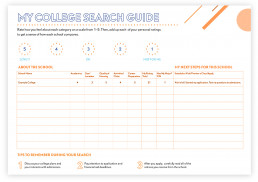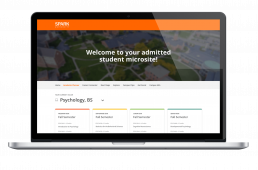Yield is a unique yet vulnerable time in the enrollment cycle for higher education institutions. Admitted students can choose to either commit to your university or simply go elsewhere. Successful yield involves engaging your admitted students early, and often, by offering meaningful information to the students and their families. Most importantly, engaging students means building relationships and a foundation of trust at every opportunity.
When students begin their college search, they start by visiting campuses that have piqued their interest. Once a student steps foot on campus, they want to feel personally connected, and many institutions are very skilled at tapping into these feelings. During tours, students start imagining themselves in various settings on campus. They think about what it would be like to eat at the dining hall, play volleyball in the quad, work out at the gym, and study in the beautiful library.
All of these feelings are likely a large part of what drives them to apply. However, after a student submits an application, it’s common for institutions to continue focusing exclusively on recruitment and application generation. In some cases, months can go by between the time a student is admitted and when the school engages them again during yield season. This is a critical problem. During this gap period, the student could be visiting other campuses, receiving communications from other institutions about applying, hearing from school ambassadors about attending a class with them, and so forth. In short, these admitted students are being continually engaged by other schools, which means that the schools that admitted them earlier in the season could be at risk of becoming a distant memory.
The reality is that institutions can’t control the decisions that students ultimately make on where they will attend, but what they can do is create more strategic and impactful communications and position themselves in a way that builds trust with prospective students and informs their decision-making. Here are three tips that can help you focus your yield efforts and maximize your reach with your admitted student pool.
Tip 1: Use Your CRM to Strategically Personalize Outreach
Have you ever seen the inbox of a student who recently took the PSAT or SAT and scored really well? I have, and there are literally hundreds of emails from colleges and universities. These communications become white noise; the student no longer pays attention to the emails because there are just so many.
However, let’s say that your school was able to push through the white noise and garner an application from this highly sought-after student, and you have admitted them. You can be sure that this student has plenty of offers to choose from. This begs the question: What can your institution do to stand out from other schools?
Oftentimes, communications are sent as a means of sharing information and do not warrant a response. For example:
“Reminder: Spark University is having our Admitted Student Day on 3/11. Click here to register.”
These messages have a purpose in that we want to remind the student to register for Admitted Student Day. However, we want to mix these types of communications with more personalized messages that encourage the recipient to start a conversation with you. One example of a personalized message might look like:
“Hi, this is Julie, your Admissions Counselor at Spark University. Congrats on being admitted to Spark! I saw you visited campus last week. Are there any questions that came up after you got home?”
This type of message serves multiple purposes. It is a nice introduction of your admissions staff member; it provides a specific point of contact for that student; and the message is personalized to them and their experience.
You may be thinking, “How can my busy staff send out so many personalized messages to admitted students? How do I make time for this?” With your CRM, you can efficiently deliver personalized messages to your admitted students at scale. (Need help? The Spark451 team has experience creating, sending, and managing personalized communication workflows in whichever CRM you’re working in, and we’d be happy to discuss how you can leverage its capability to engage admitted students.)
Tip 2: Take a Consultative Sales Approach
When you adopt a consultative sales mindset, it means that you stop viewing yourself primarily as a representative of your institution, and instead, as a personal advisor to each student and family you work with. When communicating with admitted students and their families, the focus should be on building the relationship first. It’s important to be genuinely curious about a student’s needs, wants, and concerns. Once you feel that trust has been established, work with the student to encourage them to deposit at your school. Or, as the relationship develops, it’s okay if it becomes apparent that the student is not a good fit for your school. As an admissions/enrollment professional, of course it’s your responsibility to enroll students, but it is also your responsibility to be concerned about retention. If a student is not a good fit for your school, it is likely that the student will eventually contribute to the institution’s attrition rates.
Achieving your institution’s enrollment goals is critical, but fostering relationships, supporting students and their families, and helping them understand complex information to find the right fit should also be a top priority. Keep in mind, this approach not only engages the students that you have targeted for enrollment, but it also engages the biggest influencers for students — their parents or caretakers. Delivering excellent advice and helpful service to those key influencers is another way for an institution to set themselves apart from their competitors.
Tip 3: Make Comparing Your School to Other Schools Easy for Students and Families
Like I mentioned above, being helpful is necessary and extremely appreciated by admitted students. Many students apply to multiple schools. Once they are admitted, they spend many hours comparing their top schools until they come to a decision. If they have a hard time finding what they need to make those comparisons, your school will be immediately off the table. Consider creating a college comparison checklist so your students can easily rate how they feel about the most important categories impacting their decision.

Rule of thumb: All applicable information for admitted students should be in one place and easy to find. At Spark451, we provide a robust personalized microsite for admitted students. This is where students can find all of the details needed to make a well-informed decision about where to attend. (We’d be happy to discuss our personalized microsites with you more, so your school can maximize its ability to provide all necessary information to admitted students and their families.)

These are tips you can start implementing today, but here at Spark451, we also offer more robust, larger scale yield strategies. We would be happy to discuss how we can help assist your school with yield and meet your enrollment goals — reach out today!
